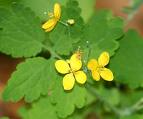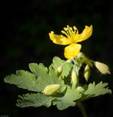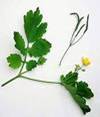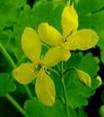| Kingdom | Plantae |
| Division | Magnoliophyta |
| Class | Magnoliopsida |
| Order | Ranunculales |
| Family | Papaveraceae |
| Genus | Chelidonium |
| Species | C. majus |
| Binomial name | Chelidonium majus |
Other Common Names:
The other common names for the herb celandine are Garden Celandine and Common Celandine.
History
Celandine is a pale green, fleshy herb, indigenous to Europe and naturalized in the United States; it grows along fences, by roads, in waste places, etc., and flowers from May to October. Celandine was a drug plant in the Middle Ages and is mentioned by Pliny, to whom we owe the tradition that it is called Chelidonium from the Greek chelidon (a swallow), because it comes into flower when the swallows arrive and fades at their departure.

Description
The Celandine is an herbaceous perennial. The root is thick and fleshy. The stem, which is slender, round and slightly hairy, grows from 1 1/2 to 3 feet high and is much branched; at the points where the branches are given off, it is swollen and jointed and breaks very easily. The plant consists of a rosette of basal leaves during the first year. The alternate compound leaves are up to 6" long and 3" across; they are pinnate-pinnatifid or bipinnatifid and hairless to mostly hairless. Each compound leaf typically has 5 leaflets or lobes that are ovate or obovate in overall shape.



The whole plant abounds in a bright, orange-coloured juice, which is emitted freely wherever the stems or leaves are broken. This juice stains the hands strongly and has a persistent and nauseous taste and a strong, disagreeable smell. It is acrid and a powerful irritant.
Range
Greater Celandine has naturalized in a few scattered counties in Illinois, where it is uncommon and usually doesn't persist. This species was introduced from Europe as an herbal plant and it is still cultivated in gardens.
Habitat
Celandine is usually found by old walls, hedges and waysides and in untilled places. Once planted in a garden, especially in a shady place, it will remain there. It is always common in the neighbourhood of human habitations.
Cultivation
Sow seed in situ in spring for best results. For maximum freshness, please keep seed refrigerated in its original packaging until it is time to plant. Propagation: Celandine can be propagated by seeds or by division. Seed into plug trays or directly into the field. The seed will germinate in 2 - 3 weeks. It can be grown in full sun or partial shade. Regular watering is necessary. It can tolerate most soil types but grows best in rich soil. Above ground parts are harvested in the spring or early summer.
Parts Used
The whole herb of the celandine is used for its medicinal and commercial purposes.
Flowering Season
The flowers of the celandine are generally in bloom through out the summer.
Pests and Diseases
Celandine are commonly affected by sap sucking insects, mites and gall maker insects. They are infected by diseases like root and butt diseases, foliage diseases, stem, cone and broom rusts.
Medicinal and Commercial Applications


• Celandine helps in treating the yellow jaundice, the dropsy and the itch and old sores in the legs and other parts.
• The herb is used by professional herbalists as a cholagogue and hepatic tonic and purifies the blood, increases urine production.
• The fresh juice is still considered to be an effective application for corns and warts.
• It is used as an eye lotion to remove film on the eyes.
• Chewing the root relieves toothache.
• It is used in jaundice, eczema, scrofulous diseases and scurvy.
• The addition of a few aniseeds in making a decoction of the herb in wine has been held to increase its efficacy in removing obstructions of the liver and gall.
• An ointment made of the roots and lard boiled together, also of the leaves and flowers, has been used with advantage for piles.
• Celandine is a very popular medicine in Russia, where it is said to have proved effective in cases of cancer.
• Celandine is also used in curing salt-rheum, tetter, or ringworm.


PIt is one of the twenty-four herbs mentioned in Mercer's Herbal. In the fourteenth century, a drink made with Celandine was supposed to be good for the blood. Clusius, the celebrated Dutch botanist, considered that the juice, dropped into small green wounds, effected rapid cure, and when dropped into the eye would take away specks and stop incipient suffusions. The old alchemists held that it was good to 'superstifle the jaundice,' because of its intense yellow colour.
A fine gamboge-yellow, acrid juice, pervades the plant, root, stem and leaves; this fact led those who practised upon the doctrine of signatures, to employ the drug in hepatic disorders, from its resemblance to bile in color.Celandine can be protective and confusing to enemies and it is said to keep off both witches and law officers, and it can be burned as incense or added to floor scrubs for that purpose. Mixed with Poppy Seeds, it is said to help criminal defendants win in court by confusing the testimony of the police.